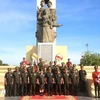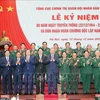Vietnam and Laos have completed a project to upgrade and increase their field border markers and a ceremony to celebrate this event will be held at the Thanh Thuy ( Vietnam ’s Nghe An province) and Nam on ( Laos ’ Bolikhamsai province) Border Gate on July 9.
On the occasion, Foreign Minister Pham Binh Minh has written an article on the upgrade and increase of border markers between Vietnam and Laos . Vietnam News Agency would like to introduce a translated excerpt of the article.
Vietnam and Laos share a border of more than 2,000km running from north to south. This is the longest land borderline that Vietnam shares with a neighbouring country. With the borderline running along the two countries, Vietnam and Laos have developed a traditional special friendship, solidarity and close attachment with their people assisting each other through either country’s history. During the fight for national liberation and independence, even in the most difficult period, the two countries always stood side by side in the spirit of ‘sharing the same grain of salt and stem of vegetable’. During this difficult but glorious time, many sites along the shared border between the two nations became immortal, attached to brilliant feats of arms of the revolutionary soldiers of Vietnam and Pathet Laos.
Following Vietnam’s reunification and the Lao Revolution’s nationwide victory, despite economic difficulties and a full of work to restore the countries after the wars, the two Parties, States and Governments still paid special attention to the territorial border task. On July 18, 1977, Vietnam and Laos signed the ‘Treaty on Delimitation of National Boundaries’, laying political and legal foundations for border demarcation and marker planting between the two countries.
In 1987, after nine years of enormous efforts to overcome difficulties and hardships, Vietnam and Laos completed their field border demarcation and marker planting. The two countries planted 214 markers in 199 positions. On January 24, 1986, the Supplementary Treaty to the 1976 Treaty on Boundary Delimitation and Protocol on Border Demarcation and Border Planting on the Field were signed and the Supplementary Protocol to the Protocol on Field Border Demarcation and Border Planting was inked on October 16, 1987. With these results, the Vietnam-Laos borderline was demarcated, marked out and clearly shown in the Vietnam-Laos national border map at a scale of 1/50,000 published in 2003 using modern digital technology.
However, the borderline between the two countries together with a system of national border markers were built at a time when the two countries faced economic difficulties. Consequently, the distances between markers was too long, in some sections it extended nearly 40km. Added to this, their quality was not good enough to stand up to severe weather conditions, affecting the terrain of the two countries’ borderline. These facts required the two nations to upgrade and consolidate the system.
In 2008, when economic conditions were well enough, the two Governments agreed to ratify and implement a project to upgrade and increase border markers along the Vietnam-Laos borderline in order to build an official and modern national border marker system that matches each country’s realities and meets border management and protection requirements in the new context. The project aimed to increase the number of markers and upgrade existing ones to clearly identify the borderline in the field, and complete legal documents on the Vietnam-Laos borderline.
The Vietnam-Laos border areas have rough topography with high mountains and deep chasms, no roads and harsh weather. In many places, in order to build a border marker, tens of kilometres of public service roads to transport construction materials and border pillars were required. To conduct field surveys and identify the locations of markers, in some cases, the two countries’ demarcation forces had to walk for ten days, passing many kilometres of forest road to reach the marker area. Particularly challenging marker areas were in Dien Bien and Quang Nam provinces and western Nghe An province. To complete marker planting, those in charge had to get to each location for building, checking and handing over. Most of the locations for marker planting were in remote areas with socio-economic difficulties, thus it was hard applying technology and mobilising human resources. To transport the markers undamaged through difficult terrain was really a challenge.
Thanks to the efforts of the two countries’ joint committee on border marker planting, relevant ministries, agencies and localities, especially those directly involved in field border marker planting, Vietnam and Laos officially completed the increase and upgrade of border markers along their border, positioning 835 border markers in 793 locations and 20 benchmark pillars.
The project to upgrade and add new border markers along the Vietnam-Laos shared border is important and significant in terms of security, politics and socio-economics. It is a sensitive work relating to territorial sovereignty and national interests that meets both immediate and long-term requirements. It is also a comprehensive task involving the two countries’ various areas and forces from central to local levels.
The accomplishment of the work in the field is a great victory of special significance, creating a premise for the next stage of finalising legal documents so that the whole project may be completed in 2014. Since now, the modern and clear border marker system will create favourable conditions for the border management and protection, trade and investment cooperation, people-to-people exchange as well as cultural and tourism exchanges between the two countries’ border areas. It will contribute to consolidating political security, social order and safety, border security and defence while boosting the friendship and comprehensive cooperation between the two neighbours.
The event will go into the history of both countries as a fruit of the Vietnam-Laos special cooperation, manifesting a high consensus, mutual trust and understanding between the two Parties, States and peoples. It is a vivid symbol of the traditional friendship, special solidarity and comprehensive cooperation between the two countries based on the principle of respecting either side’s independence, sovereignty, territorial integrity and legitimate interests, as well as equality and common benefits for a border of peace, stability and cooperation for mutual development and interests of the two peoples.
The achievement is obtained thanks to the attention and close instruction of the two countries’ Party, State and Government leaders as well as the high resolve of their relevant ministries, branches and localities. In particular, officers and soldiers who have directly taken part in border marker planting have united and worked closely with each other to overcome various difficulties and dangers to fulfil their assigned tasks.
The successful project is also attributable to the valuable contributions and support of ethnic groups residing in the two countries’ border areas. Despite a range of difficulties, they have wholeheartedly backed the work, both materially and spiritually. Several officers and soldiers have laid down their lives while performing their border demarcation and marker planting tasks in the past as well as implementing the project. Their blood has absorbed into the land, contributing to the present victory. In the joyful atmosphere, we commemorate them and express our deep gratitude to their sacrifice.
With the modern and everlasting border marker system, the Vietnam-Laos borderline will be a venue of friendship and close cooperation forever for the prosperity of both countries, meeting their people’s aspirations and the resolve of the two countries’ leaders.
In the coming time, the two sides need to keep working closely and immediately join hands to build legal documents acknowledging their achievements in increasing and upgrading border markers, including the Protocol on Border Demarcation and Marker Planting , the new Agreement on Border Management Regulations and the Vietnam-Laos Border Gates and Border Gate Management Regulations in order to satisfy border management requirements in the new situation. Special attention will be paid to building and completing socio-economic infrastructure, facilitating economic development and consolidating security and national defence in the two countries’ border areas, contributing to enhancing the strategic relations and comprehensive cooperation between the two nations. We believe that with the determination and efforts of the two Parties, States and peoples, the entire project will be completed by 2014, meeting every citizen’s aspirations.-VNA
On the occasion, Foreign Minister Pham Binh Minh has written an article on the upgrade and increase of border markers between Vietnam and Laos . Vietnam News Agency would like to introduce a translated excerpt of the article.
Vietnam and Laos share a border of more than 2,000km running from north to south. This is the longest land borderline that Vietnam shares with a neighbouring country. With the borderline running along the two countries, Vietnam and Laos have developed a traditional special friendship, solidarity and close attachment with their people assisting each other through either country’s history. During the fight for national liberation and independence, even in the most difficult period, the two countries always stood side by side in the spirit of ‘sharing the same grain of salt and stem of vegetable’. During this difficult but glorious time, many sites along the shared border between the two nations became immortal, attached to brilliant feats of arms of the revolutionary soldiers of Vietnam and Pathet Laos.
Following Vietnam’s reunification and the Lao Revolution’s nationwide victory, despite economic difficulties and a full of work to restore the countries after the wars, the two Parties, States and Governments still paid special attention to the territorial border task. On July 18, 1977, Vietnam and Laos signed the ‘Treaty on Delimitation of National Boundaries’, laying political and legal foundations for border demarcation and marker planting between the two countries.
In 1987, after nine years of enormous efforts to overcome difficulties and hardships, Vietnam and Laos completed their field border demarcation and marker planting. The two countries planted 214 markers in 199 positions. On January 24, 1986, the Supplementary Treaty to the 1976 Treaty on Boundary Delimitation and Protocol on Border Demarcation and Border Planting on the Field were signed and the Supplementary Protocol to the Protocol on Field Border Demarcation and Border Planting was inked on October 16, 1987. With these results, the Vietnam-Laos borderline was demarcated, marked out and clearly shown in the Vietnam-Laos national border map at a scale of 1/50,000 published in 2003 using modern digital technology.
However, the borderline between the two countries together with a system of national border markers were built at a time when the two countries faced economic difficulties. Consequently, the distances between markers was too long, in some sections it extended nearly 40km. Added to this, their quality was not good enough to stand up to severe weather conditions, affecting the terrain of the two countries’ borderline. These facts required the two nations to upgrade and consolidate the system.
In 2008, when economic conditions were well enough, the two Governments agreed to ratify and implement a project to upgrade and increase border markers along the Vietnam-Laos borderline in order to build an official and modern national border marker system that matches each country’s realities and meets border management and protection requirements in the new context. The project aimed to increase the number of markers and upgrade existing ones to clearly identify the borderline in the field, and complete legal documents on the Vietnam-Laos borderline.
The Vietnam-Laos border areas have rough topography with high mountains and deep chasms, no roads and harsh weather. In many places, in order to build a border marker, tens of kilometres of public service roads to transport construction materials and border pillars were required. To conduct field surveys and identify the locations of markers, in some cases, the two countries’ demarcation forces had to walk for ten days, passing many kilometres of forest road to reach the marker area. Particularly challenging marker areas were in Dien Bien and Quang Nam provinces and western Nghe An province. To complete marker planting, those in charge had to get to each location for building, checking and handing over. Most of the locations for marker planting were in remote areas with socio-economic difficulties, thus it was hard applying technology and mobilising human resources. To transport the markers undamaged through difficult terrain was really a challenge.
Thanks to the efforts of the two countries’ joint committee on border marker planting, relevant ministries, agencies and localities, especially those directly involved in field border marker planting, Vietnam and Laos officially completed the increase and upgrade of border markers along their border, positioning 835 border markers in 793 locations and 20 benchmark pillars.
The project to upgrade and add new border markers along the Vietnam-Laos shared border is important and significant in terms of security, politics and socio-economics. It is a sensitive work relating to territorial sovereignty and national interests that meets both immediate and long-term requirements. It is also a comprehensive task involving the two countries’ various areas and forces from central to local levels.
The accomplishment of the work in the field is a great victory of special significance, creating a premise for the next stage of finalising legal documents so that the whole project may be completed in 2014. Since now, the modern and clear border marker system will create favourable conditions for the border management and protection, trade and investment cooperation, people-to-people exchange as well as cultural and tourism exchanges between the two countries’ border areas. It will contribute to consolidating political security, social order and safety, border security and defence while boosting the friendship and comprehensive cooperation between the two neighbours.
The event will go into the history of both countries as a fruit of the Vietnam-Laos special cooperation, manifesting a high consensus, mutual trust and understanding between the two Parties, States and peoples. It is a vivid symbol of the traditional friendship, special solidarity and comprehensive cooperation between the two countries based on the principle of respecting either side’s independence, sovereignty, territorial integrity and legitimate interests, as well as equality and common benefits for a border of peace, stability and cooperation for mutual development and interests of the two peoples.
The achievement is obtained thanks to the attention and close instruction of the two countries’ Party, State and Government leaders as well as the high resolve of their relevant ministries, branches and localities. In particular, officers and soldiers who have directly taken part in border marker planting have united and worked closely with each other to overcome various difficulties and dangers to fulfil their assigned tasks.
The successful project is also attributable to the valuable contributions and support of ethnic groups residing in the two countries’ border areas. Despite a range of difficulties, they have wholeheartedly backed the work, both materially and spiritually. Several officers and soldiers have laid down their lives while performing their border demarcation and marker planting tasks in the past as well as implementing the project. Their blood has absorbed into the land, contributing to the present victory. In the joyful atmosphere, we commemorate them and express our deep gratitude to their sacrifice.
With the modern and everlasting border marker system, the Vietnam-Laos borderline will be a venue of friendship and close cooperation forever for the prosperity of both countries, meeting their people’s aspirations and the resolve of the two countries’ leaders.
In the coming time, the two sides need to keep working closely and immediately join hands to build legal documents acknowledging their achievements in increasing and upgrading border markers, including the Protocol on Border Demarcation and Marker Planting , the new Agreement on Border Management Regulations and the Vietnam-Laos Border Gates and Border Gate Management Regulations in order to satisfy border management requirements in the new situation. Special attention will be paid to building and completing socio-economic infrastructure, facilitating economic development and consolidating security and national defence in the two countries’ border areas, contributing to enhancing the strategic relations and comprehensive cooperation between the two nations. We believe that with the determination and efforts of the two Parties, States and peoples, the entire project will be completed by 2014, meeting every citizen’s aspirations.-VNA



















